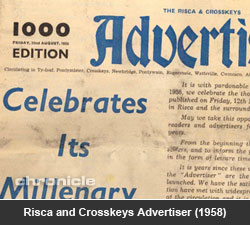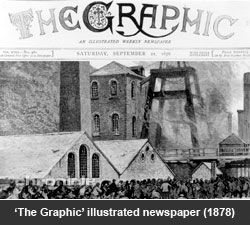
Newspapers
In medieval days gentlemen would send out duplicate handwritten letters to keep their friends or associates informed of the day’s business. With the advent of printing, these ‘news letters’ could be more widely disseminated. In 1620, the first ‘corrant’ or printed news-sheets came out of Italy, and a little later the first Coranto in English was published in Amsterdam. In 1622, the “Weekly Newes from Italy, etc;” was the first newssheet to carry the date of publication on the tile page. The abolition of the Star Chamber in 1641, and the imprisonment of Archbishop Laud, brought about a greater measure of press freedom. By 1643, Parliament were already issuing daily reports of business, and during the Civil War, there was great rivalry between the Royalist and Parliamentary papers such as the Royalist Mercurius Aulicus and the Parliamentarian Mercurius Britannicus.
In 1655, Cromwell restored the licensing system, and suppressed all newspapers except official publications such as Mercurius Politicus. After the Restoration, the Printing Act brought in stringent press control.
In 1665 the 'Oxford Gazette' was founded, and became the 'London Gazette' in February 1666. It is the world's oldest surviving periodical. After a lapse of the licensing laws in 1679, bringing in a flood of unlicensed newspapers, Parliament decided against the renewal of the Licensing Act in 1695, clearing the way for a free press.

In 1701 came the estimated first issue of the Norwich Post: probably the first provincial newspaper. The earliest surviving copy of a provincial newspaper is William Bonny's Bristol Post-Boy (No. 91). In 1709, the same year as the first Copyright Act, the Worcester Post-Man was founded. It became Berrow's Worcester Journal in 1753- Britain's oldest surviving non-official newspaper. In 1747, the Aberdeen Journal was founded, later Press and Journal, the oldest surviving Scottish newspaper.
By 1755, the 'Bath Advertiser', Bath's second newspaper, was founded to include 'Lists of the Nobility and Gentry resorting to the BATH; with an Account of Plays perform'd at both the Theatres'. In Wales, the 'Cambrian' was launched in Swansea in 1804, the first newspaper published in Wales. Then in 1808, the 'North Wales Gazette' was launched in Bangor, the first in North Wales. The 'Carmarthen Journal' was later established in 1810.
The Baptist Minister, Joseph Harris launched 'Seren Gomer' (Star of Gomer') in Swansea in 1814, the first Welsh-language newspaper. In 1822 the 'Cardiff Weekly Reporter' launched. In 1843, ;Yr Amserau' ('The Times') was founded in Liverpool by John Jones and edited by William Rees. It merged with 'Baner Cymru' ('Banner of Wales') in 1859 under Thomas Gee to become 'Baner ac Amserau Cymru'.
In November 1924 the first crossword appears in a British newspaper, in the Sunday Express. In 1954, the Manchester Sunday paper, Empire News, sets up its first Cardiff edition as 'Wales's Own Sunday Paper: Printed in Wales for Wales'. In 1973, ‘Y Dinesydd’ was launched in Cardiff; the first of the Welsh-language community papers ('papurau bro') established in Wales. Later, on March 5th 1989, the 'Wales on Sunday' was introduced in Cardiff.
Image date: unknown
Location: unknown
Submitted by: unknown
Do you have any stories, images and interesting facts relating to this picture. Help Chronicle build a website of your Caerphilly County Borough memories. Email the webmaster telling us as much as you can about your pictures. Thank you
Description: